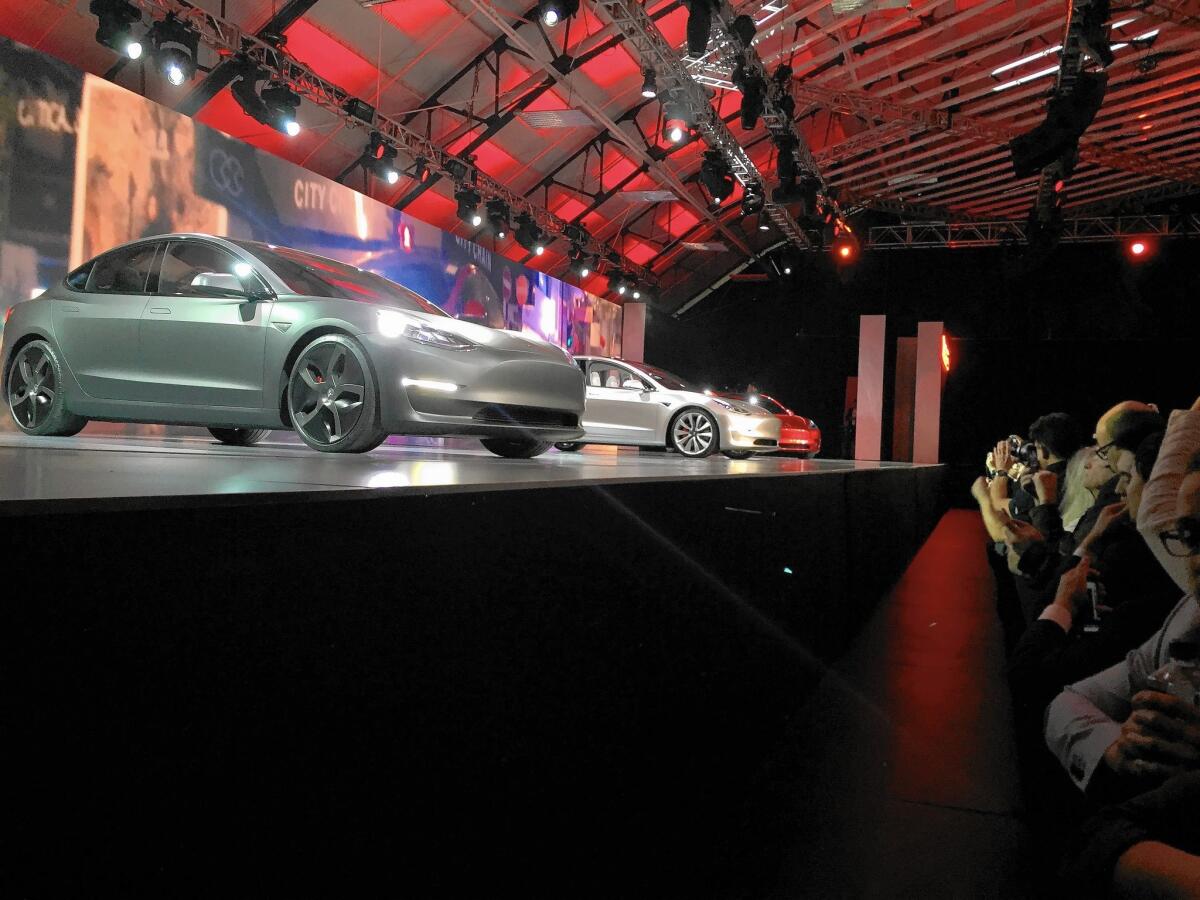Government subsidies may be gone before most buyers can get a Tesla Model 3

Pre-orders for the Tesla Model 3 have topped 276,000, with buyers lured by the electric vehicle’s coolness factor, sleek and low profile, $35,000 starting price — and the promise of thousands of dollars in government incentives.
But before customers start earmarking those subsidy savings for new rims or a thumping sound system, know this: Many government rebates could be exhausted by the time most get behind the wheel of their Model 3s.
“Buyers shouldn’t be counting on either the federal or the state level incentives as part of their financial calculations in purchasing the vehicle,” said Patrick Min, senior analyst at the automotive company ALG.
------------
FOR THE RECORD
April 6, 1:41 p.m.: An earlier version of this article incorrectly said the $7,500 federal credit runs out when a manufacturer sells 200,000 qualifying vehicles. The credit starts to gradually phase out at the 200,000 mark.
------------
A combination of federal and state financial credits have helped defray the cost of buying zero-emission or hybrid vehicles for Southern Californians: up to $7,500 in federal subsidies and $2,500 in state subsidies for Tesla owners.
But there are caveats. The federal subsidy starts to phase out once a manufacturer sells 200,000 vehicles in the U.S. And wealthy California buyers will also miss out: Starting last week, state rebates were no longer available to single filers earning more than $250,000 a year, head-of-household filers making more than $340,000 and joint filers making a combined $500,000.
According to data compiled by the research firm Polk and by the industry publication Inside Evs, Tesla to date has sold about 67,000 Model S and Model X vehicles that qualified for rebates. If the company hits its stated targets of delivering 80,000 to 90,000 vehicles this year, analysts said, those rebates could begin to drop off before the first Model 3 is slated to hit the road in late 2017.
Many of those who stood in line at Tesla’s stores around the country last week took government incentives into consideration.
Santa Monica resident Paul Scott, who was among the first to put down a deposit at his local Tesla store on the Third Street Promenade, said he was intending to order a “fully loaded” Model 3 because he believes that Tesla will build and deliver the most expensive models first.
He could spend as much as $50,000 for his model, he said, but that gives him a better chance of getting a tax credit before Tesla sells its 200,000th vehicle.
“If any of the tax credit is available, only the first Model 3s will get it,” Scott said. “But I’m fully prepared to buy the car without the tax credit.”
SIGN UP for the free California Inc. business newsletter >>
Chief Executive Elon Musk said Tesla’s rollout plan “should enable large numbers” of customers to take advantage of incentives, but analysts questioned just how many new customers would see them.
“At this pace, they’re going to burn through the available credits,” said Alan Ohnsman, spokesman for TrueCar.com, an automotive pricing and information website.
Jeremy Acevedo, pricing and industry analyst for Edmunds.com, said if there is no subsidy extension, “there’s no chance that everybody on this list is going to be able to attain the federal rebate.”
California also offers incentives, but amid a potential flood of new electric cars, those enticements could be in question.
Under the Clean Vehicle Rebate Project (CVRP), California offers up to $6,500 for the purchase or lease of new, eligible zero-emission vehicles that include electric, plug-in hybrid electric and fuel cell vehicles. Tesla owners receive $2,500.
The rebate program receives an annual allocation to distribute to clean-car buyers. The budget for the next fiscal year that starts July 1 contains $175 million, said Colin Santulli, senior manager of clean transportation for the Center for Sustainable Energy.
“What the state is going to designate for 2017, 2018, 2019, when the Tesla [Model 3] hits consumers’ driveways and they can apply for the incentives, we really can’t say,” Santulli said.
According to California Air Resources Board numbers, rebates exceeded the money allocated for the program in fiscal years 2012-13 and 2013-14.
“The state will have to look at what the demand is going to be the next time they propose allocating a budget for the program and they’re definitely going to have to take into consideration the Tesla Model 3 demand,” Santulli said.
Twitter: @robnikolewski
Times staff writer Charles Fleming contributed to this report.
MORE BUSINESS NEWS
For Disney, it’s a small, small world of possible candidates to succeed CEO Iger
Ballast Point’s Sculpin leads San Diego craft beers to robust growth in 2015
‘The Boss’ will battle ‘Batman v Superman’ for top spot at the box office this weekend



